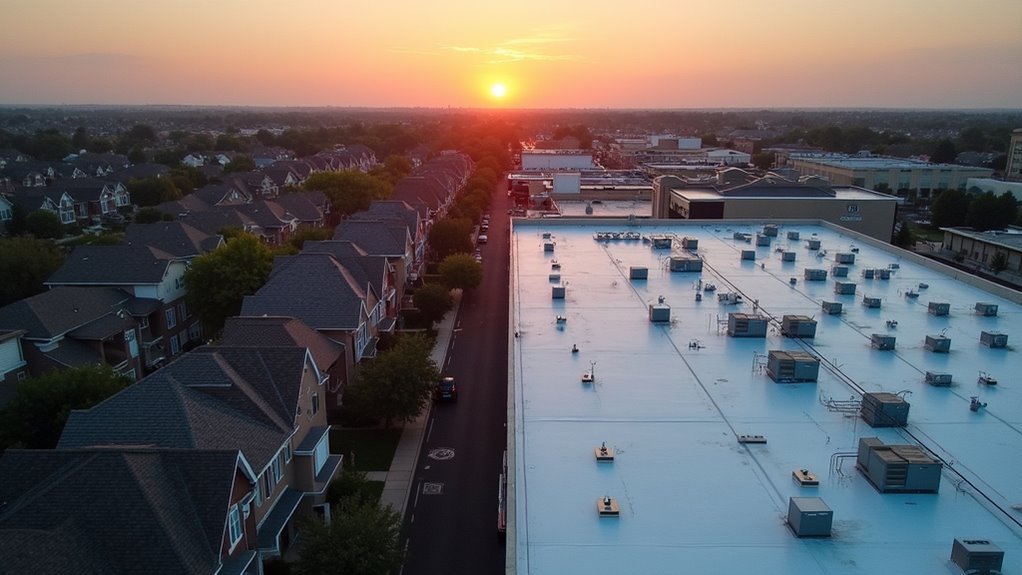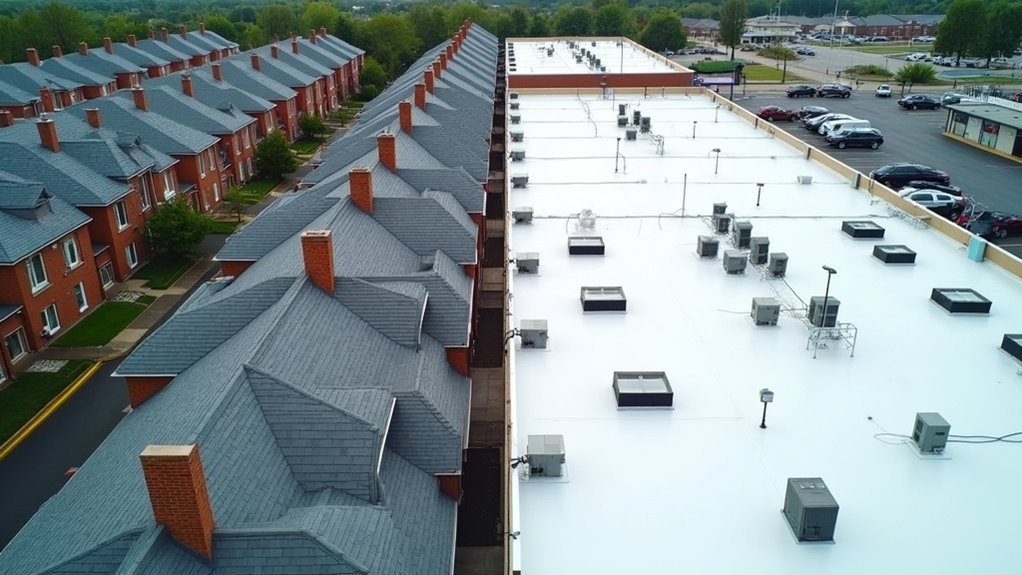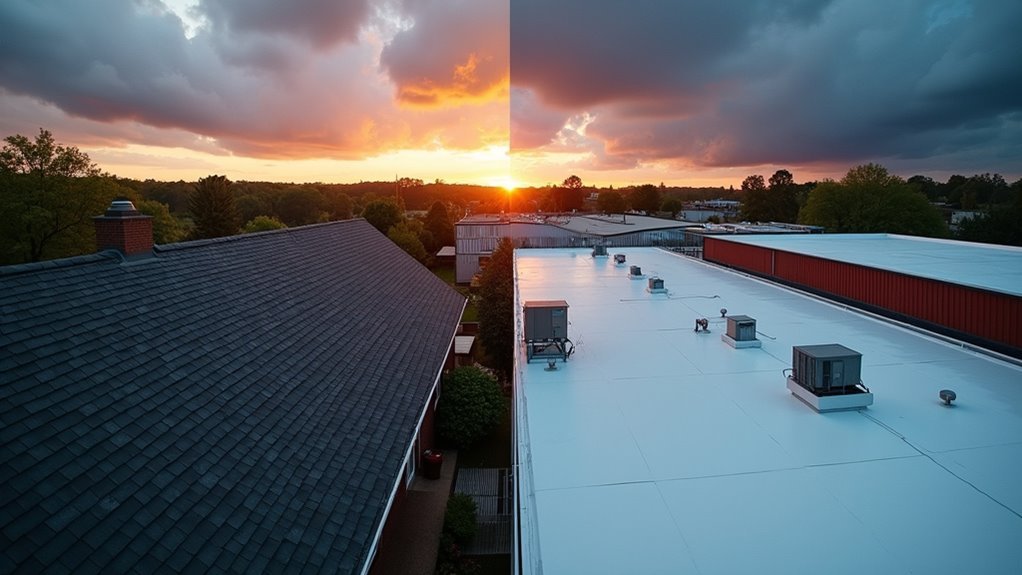Residential roofing typically covers single-family homes with steeper slopes (4:12 to 9:12), while commercial roofing protects larger business structures using low-slope or flat designs (1:12 to 3:12). You’ll find residential roofs commonly using asphalt shingles or tiles, whereas commercial projects employ specialized membrane systems like EPDM or TPO. Commercial installations require more complex planning for HVAC systems and drainage solutions, plus they demand higher technical expertise and safety protocols. Understanding these key differences helps guarantee you’ll choose the appropriate system for your specific needs.
Design and Slope Differences

While residential and commercial roofs serve the same basic purpose of protection, their designs differ significantly in both form and function. Residential roofs typically feature steeper slopes, ranging from 4:12 to 9:12, with simpler roof geometry that accommodates straightforward drainage and ventilation systems.
In contrast, you’ll find that commercial roofs often have low-slope or flat designs, usually between 1:12 and 3:12, requiring more complex drainage solutions. This design choice stems from practical considerations: commercial buildings need to increase interior space while supporting HVAC units and other equipment on the roof. The structural integrity of commercial roofs must withstand greater loads, which affects material selection and installation methods. You’ll also notice that commercial roofs generally cover larger surface areas and incorporate more sophisticated waterproofing systems.
Material Options and Applications
Material selection represents one of the starkest contrasts between residential and commercial roofing applications. You’ll find residential roofs commonly feature asphalt shingles, cedar shakes, or clay tiles, while commercial projects typically employ built-up roofing (BUR), modified bitumen, or single-ply membrane systems like EPDM and TPO. The distinct installation requirements for each material type drastically impact your project’s timeline, with commercial materials often requiring specialized equipment and technical expertise for proper application.
Common Residential Materials Used
Residential roofing materials encompass a diverse range of options that vary in durability, aesthetics, and cost-effectiveness. You’ll commonly find asphalt shingles dominating the market due to their affordability and ease of installation. Metal roofing, including aluminum and steel, offers superior longevity and integrates well with modern gutter systems and roof ventilation solutions.
Clay and concrete tiles provide exceptional durability and distinct architectural appeal, particularly in Mediterranean or Spanish-style homes. Wood shakes and shingles deliver natural beauty and insulation properties but require more maintenance. Slate roofing, while expensive, offers unmatched elegance and can last over a century when properly maintained. Synthetic materials like composite and rubber tiles are gaining popularity for their ability to mimic traditional materials while offering improved performance characteristics.
Commercial Roofing Product Types
Commercial roofing products diverge substantially from residential options, focusing on durability and functionality across larger surface areas. You’ll find several membrane types commonly used, including EPDM (synthetic rubber), TPO (thermoplastic polyolefin), and PVC (polyvinyl chloride). These materials excel in protecting expansive commercial spaces while meeting strict building codes.
Modified bitumen and built-up roofing (BUR) systems offer multilayer protection, ideal for buildings with heavy HVAC equipment. Energy efficiency considerations play a pivotal role in material selection, with cool roofing options like white TPO membranes reflecting sunlight and reducing cooling costs. Metal roofing systems, particularly standing seam varieties, provide longevity and weather resistance for industrial applications. Each system requires specific installation techniques and maintenance protocols to guarantee premier performance throughout its lifecycle.
Unique Application Requirements
Installation requirements between residential and commercial roofing differ substantially in their complexity and scope. When you’re planning either project, you’ll need to examine specific application requirements that impact environmental impact and sustainability considerations.
| Aspect | Residential | Commercial |
|---|---|---|
| Installation Time | 2-3 days | 2-3 weeks |
| Equipment Needed | Basic roofing tools | Heavy machinery |
| Crew Size | 3-5 workers | 10-20 workers |
| Access Requirements | Simple ladder access | Crane/lift equipment |
| Safety Protocol | Standard safety gear | Amplified safety systems |
Commercial installations demand extensive planning for HVAC systems, multiple penetrations, and drainage solutions. You’ll need specialized crews trained in commercial-grade materials and application techniques. Residential applications focus on aesthetic appeal and weather protection, typically requiring simpler installation methods and fewer penetrations through the roof surface.
Installation Requirements and Complexity
The complexity of roofing installations varies considerably between residential and commercial projects, with commercial roofs typically requiring specialized knowledge of low-slope systems and extensive safety protocols. You’ll find that commercial installations demand rigorous adherence to multi-layer assembly techniques, including proper vapor barriers, insulation layers, and membrane applications. While residential roofing commonly features steeper pitches that facilitate natural drainage, you’ll need extra safety equipment and fall protection systems for both types, though commercial projects often require more extensive setups due to their larger scale and complexity.
Slope and Pitch Differences
While residential roofs typically feature steep slopes between 4/12 and 9/12 pitch, commercial roofing systems often incorporate low-slope or nearly flat designs ranging from 1/4/12 to 3/12 pitch. This fundamental roof angle variation impacts everything from material selection to drainage requirements.
You’ll find that residential steep slopes allow for better water runoff and create opportunities for architectural aesthetics using shingles, tiles, or metal panels. These roof slope changes also provide usable attic space and effective ventilation. In contrast, commercial buildings’ low slopes optimize interior space and accommodate HVAC equipment, but they require specialized membrane systems to prevent water pooling. The flatter design demands careful attention to drainage solutions and regular maintenance to facilitate proper water flow across the expansive surface area.
Safety Equipment Demands
Different slope configurations necessitate distinct safety protocols and equipment requirements for both residential and commercial roofing projects. When you’re working on commercial roofs, you’ll need to follow stricter protective gear guidelines due to the larger scale and complexity of these projects. OSHA standards adherence is indispensable for both types, but commercial projects often require supplementary safety measures.
- Commercial roofing demands extensive fall protection systems, including permanent anchor points and guardrails
- Residential projects typically require personal fall arrest systems and roof brackets
- Commercial sites need designated safety zones and warning lines due to larger work areas
- Both types require hard hats, non-slip boots, and appropriate weather protection gear
- Commercial projects often require specialized equipment for handling heavy materials and maintaining proper ventilation systems in enclosed spaces
Multi-Layer System Assembly
Multiple layers in commercial roofing systems create substantially more complex installation requirements compared to residential applications. You’ll find that commercial roofs typically require precise substrate composition analysis and specialized layering techniques to guarantee proper adhesion between multiple membrane layers.
While residential roofs mainly involve single-layer shingle installation, commercial projects demand careful consideration of vapor barriers, insulation boards, cover boards, and waterproofing membranes. You’ll need to account for the specific sequence of these layers, ascertaining each component properly integrates with adjacent materials. The substrate composition must support the combined weight of these systems while maintaining structural integrity.
You must also consider thermal movement, moisture control, and drainage patterns when installing each successive layer, as improper assembly can lead to premature system failure or reduced performance.
Cost Factors and Budget Considerations
The cost factors between residential and commercial roofing projects diverge considerably due to their distinct scope, materials, and labor requirements. You’ll need to understand these differences when planning your budgeting strategies and exploring financing options for either type of project.
- Commercial roofs typically cost $5-12 per square foot more than residential due to specialized materials and equipment requirements
- Residential projects often allow for simpler financing options through home improvement loans or contractor payment plans
- Commercial projects require higher insurance coverage and permits, increasing in general costs
- Scale impacts pricing – commercial projects offer bulk material savings but need more specialized labor
- Long-term maintenance costs differ vastly, with commercial roofs requiring more frequent professional inspections and systematic maintenance schedules
These cost variations directly influence your choice of materials, contractors, and project timeline planning.
Maintenance and Repair Protocols

Maintaining residential and commercial roofs demands distinctly different protocols, reflecting their unique structural intricacies and access requirements. For residential roofs, you’ll typically follow annual inspection schedules, focusing on shingle integrity, flashing conditions, and gutter maintenance. You can often complete these tasks using basic equipment and safety gear.
Commercial roofs require more intensive preventive maintenance protocols due to their larger scale and complex mechanical systems. You’ll need to implement quarterly inspections, addressing HVAC units, drainage systems, and membrane conditions. These inspections must account for foot traffic patterns, equipment placement, and specialized roofing materials. You’ll also need to maintain detailed documentation of all repairs, inspections, and maintenance activities to guarantee warranty compliance and track the roof’s performance over time.
Structural Support and Load-Bearing Requirements
While proper maintenance guarantees longevity, structural support systems form the foundation of any roofing project’s success. The key differences between residential and commercial roofs lie in their load-bearing capacity and weight distribution requirements.
- Commercial roofs must support heavier HVAC systems, requiring reinforced structural reinforcement and calculated load distribution
- Residential roofs typically handle simpler loads, mainly focusing on weather protection and basic ventilation systems
- Commercial buildings need precise engineering to manage extensive flat surfaces and mechanical equipment weights
- Residential structures utilize pitched designs that naturally distribute weight across supporting walls
- Commercial properties often require steel beam support systems, while residential homes rely primarily on wooden trusses
You’ll need to ponder these structural factors when planning either type of roofing project, as they directly impact material selection and installation methods.
Lifespan and Durability Expectations

Most roofing professionals understand that commercial and residential roofs face distinct durability challenges, resulting in markedly different life expectancies. Commercial roofs typically last 20-30 years, while residential roofs average 15-25 years, depending on materials and maintenance.
You’ll find that commercial roofs often have higher durability ratings due to their substantial materials and multiple protective layers. These systems must withstand heavy equipment, frequent maintenance traffic, and extensive HVAC installations. In contrast, residential roofs focus on aesthetic appeal and weather resistance for simpler structural demands.
When you’re evaluating longevity expectations, consider that commercial roofs generally require more frequent inspections and preventive maintenance to achieve their full lifespan potential. Residential roofs, while requiring less intensive maintenance, need regular attention to gutters and shingles to maintain their protective qualities.
Frequently Asked Questions
Can a Residential Roofing Contractor Legally Work on Commercial Buildings?
You’ll need to check your local licensing requirements carefully, as rules vary by jurisdiction. While residential contractors can sometimes work on commercial buildings, they’ll typically need specific commercial licensing and supplemental insurance coverage. The scope of work on commercial projects often requires different expertise, certifications, and equipment. If you’re a residential contractor wanting to work commercially, you should obtain proper commercial licensing and training initially.
How Does Weather Affect the Choice Between Residential and Commercial Roofing?
Weather profoundly influences your roofing choices based on durability requirements and maintenance needs. For commercial buildings, you’ll need materials that can withstand extreme temperatures and heavy equipment loads, often requiring frequent inspections. Your residential roof, while still weather-resistant, typically faces less severe exposure and can use lighter materials. You’ll find that commercial roofs commonly use flat EPDM or TPO membranes, while residential roofs favor asphalt shingles for better water runoff.
Are Insurance Requirements Different for Residential Versus Commercial Roofing Projects?
You’ll find significant differences in insurance coverage needs between residential and commercial roofing projects. Commercial projects typically require higher liability coverage limits due to increased project scale and complexity. While residential jobs might need $500,000 to $1 million in coverage, commercial projects often demand $2-5 million or more. Liability considerations also differ, as commercial projects face greater risks from employee accidents, property damage, and business interruption claims.
What Certifications Do Roofers Need for Residential Compared to Commercial Work?
You’ll need different certifications based on the type of roofing work you perform. For residential projects, you typically need a general contractor’s license and manufacturer-specific certifications. Commercial work requires supplementary credentials, including specialized equipment knowledge for handling industrial materials and OSHA safety certifications. Both fields demand ongoing training requirements to stay current with new materials, techniques, and safety protocols. Most states also mandate continuing education hours for license renewal.
Can Residential Roofing Materials Be Used on Small Commercial Buildings?
You can use residential roofing materials on small commercial buildings, but you’ll need to carefully evaluate roof material compatibility and structural load considerations initially. While asphalt shingles and similar residential materials might work for smaller commercial structures, you’ll need to guarantee they meet local building codes and weight requirements. It’s critical to have a professional assess if your commercial building’s structure can support residential materials before proceeding with installation.





